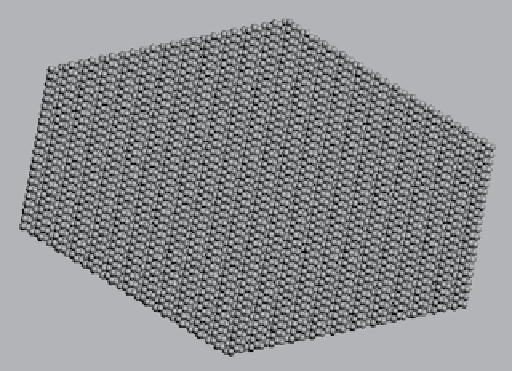Environmental Engineering Reference
In-Depth Information
The effective pressure
P
eff
due to surface tension in a particle of radius
R
is estimated by applying the laplace-young
equation:
eff
=
2σ
(10.9)
P
R
The volume dilation
e
due to the effect of surface tension is given by:
=
2βσ
e
(10.10)
R
where
β
is the compressibility.
A numerical minimization procedure is employed to determine the crystal shape with the lowest free energy for a given
nanoparticle size using values of
γ
i
and
σ
i
calculated by density functional theory for clean and hydrated low index surfaces of
anatase and rutile [75]. Anatase is the thermodynamically stable phase for particle sizes below approximately 10 nm in vacuum
and approximately 15 nm in water, although metastable anatase can persist even for particle diameters greater than this. The
phase transition corresponds to the point of intersection of the theoretically calculated free energies. for very small crystals
(<3-nm diameter) the contribution to the total surface energy from the edge and corner components may in addition become
significant [78]. Since
γ
and
σ
are sensitive to the surface state, the shape and phase stability of TiO
2
nanocrystals depend on the
degree of hydrogenation [75, 76]. It is well known that pH influences both the particle size and the shape in sol-gel preparation
of nanoscale titanium dioxide [79]. This allows the possibility of controlling the morphology and phase transition by modifying
the surface chemistry; environmentally sensitive phase maps for TiO
2
nanocrystals can be constructed using the phase bound-
aries derived from the thermodynamic model [80].
Natural anatase crystals typically exhibit a truncated tetragonal bipyramidal shape, which has also been observed in the
nanocrystalline form [81]. This morphology is characterized by A, the side of the base of the pyramid, and B, the side of the
square {001} facets at the opposing ends of the crystal [79]. The ratio B/A defines the degree of truncation. As a result of the
size dependence of the total free energy, this ratio is smaller for nanocrystals than for macroscopic crystals. Simulated images
of anatase nanocrystals [82, 83] generated by the thermodynamic model and the standard Wulff construction are contrasted in
figure 10.4; only the Ti atoms are shown for clarity and to facilitate comparison with transmission electron micrographs. The
shape predicted by the thermodynamic theory corresponds closely to that of anatase nanoparticles synthesized under near-
equilibrium conditions by the sol-gel [84] or hydrothermal routes [85], as confirmed by the high-resolution transmission elec-
tron micrograph in figure 10.5. conversely, the shape of nanocrystals synthesized under nonequilibrium conditions by gas-phase
crystallization can deviate considerably from the theoretical equilibrium morphology [86].
(a)
(b)
figure 10.4
Simulated anatase TiO
2
nanocrystals in the [100] projection based on: (a) the Wulff construction; (b) the thermodynamic
model. Reproduced with permission from Ref. [83]. © 2011, Nano Science and Technology Institute.


